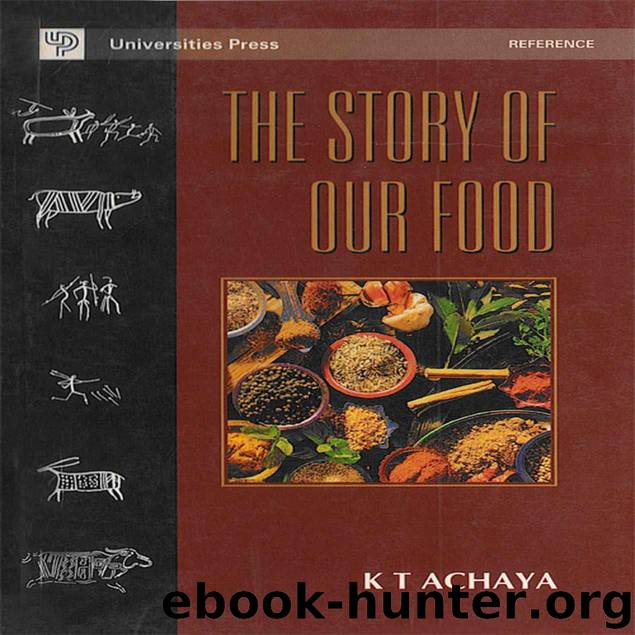The Story of Our Food by Achaya K T

Author:Achaya, K T
Language: eng
Format: epub
ISBN: 978 81 7371 835 9
Publisher: Universities Press (India) Private Limited
Published: 2012-12-03T16:00:00+00:00
7 THE MUSLIM CONTRIBUTION
From about 700 AD, and continuing for nearly 300 years, small Arab Muslim kingdoms existed in the province of Sind, which is now part of Pakistan. In the next millenium, for nearly two centuries, warlike chieftans like Mahmud Ghazni and later Muhammad Ghori made repeated raids into India with the sole intention to plunder and rapture rich booty. And then from 1206 AD came the actual occupation of north India, and the setting up in Delhi of what are now called the Sultanates. The first of these was the Slave Dynasty, then came the Khaljis and the Tughlaks, and these were followed by the Sayyids and the Lodis. In 1526, on his fifth expedition into India, Babar won the Battle of Panipat, and established in Delhi the Mughal dynasty. For the next two centuries, under six emperors, a magnificent empire was established whose glory became known far and wide.
This long interaction of people of the Muslim faith with India influenced many things in this country, including our food. Of course, the ingredients that were used remained more or less the same. What really changed were the ways of using them and the styles of cooking. Also, the Muslim rulers set the style for an elaborate code of table manners which was different from the prevailing Hindu ethos. Another significant contribution of the Mughal rulers to India was the systematic cultivation of fruit orchards. With their passion for good fruit, peaches, pears, cherries, grapes, melons and mangoes were cultivated with great diligence and became extremely abundant. Eating the first melons and grapes of fine varieties that he had caused to be raised in Hindusthan, Babar wrote,
filled my measure of content.
Food items
Even items of food that were known already in India became enriched and almost transformed. From very early times, palao was known in India, and was referred to in Sanskrit by this very name, or as mamsaudana (meat-rice). In fact, we read in the Ramayana that the favourite food of Sita was a palao made of deer meat. However, the biriyani, shulla and shurba of the Muslim cuisine were more elaborate. The meat was cooked till it was almost about to disintegrate and become part of the rice. Spices like turmeric, pepper and cumin seed (jeera) were included, and there was a free use of strong aromatic spices called garam masala, which included cloves, cardamom and cinnamon. Exotic ingredients like the stamens of zafran or saffron (kesar), with their beautiful colour and strong fragrance, were freely employed. Various nuts like almonds and pistachios were used, and raisins were scattered throughout the rice. The word biriyani itself is derived from birinj, which is simply the Persian word for rice.
Roasting pieces of meat on spits over an open fire have long been described in Sanskrit literature, for example in the Ramayana. The Muslim culinary genius transformed this into numerous varieties of kababs like seekh kabab and shammi kabab, each with its own texture and flavour. A cutler called shikampoor was
Download
This site does not store any files on its server. We only index and link to content provided by other sites. Please contact the content providers to delete copyright contents if any and email us, we'll remove relevant links or contents immediately.
| Culinary Biographies | Essays |
| Food Industry | History |
| Reference |
A Court of Wings and Ruin by Sarah J. Maas(7651)
The Death of the Heart by Elizabeth Bowen(3552)
The Sprouting Book by Ann Wigmore(3543)
Better Homes and Gardens New Cookbook by Better Homes & Gardens(3525)
BraveTart by Stella Parks(3395)
Salt, Fat, Acid, Heat: Mastering the Elements of Good Cooking by Nosrat Samin(3108)
Sauces by James Peterson(3051)
Kitchen confidential by Anthony Bourdain(3009)
The Bread Bible by Rose Levy Beranbaum(3004)
Classic by Mary Berry(2942)
Solo Food by Janneke Vreugdenhil(2929)
Ottolenghi - The Cookbook by Yotam Ottolenghi(2871)
Martha Stewart's Baking Handbook by Martha Stewart(2796)
Day by Elie Wiesel(2720)
Betty Crocker's Good and Easy Cook Book by Betty Crocker(2679)
The Plant Paradox by Dr. Steven R. Gundry M.D(2547)
My Pantry by Alice Waters(2546)
The Kitchen Counter Cooking School by Kathleen Flinn(2486)
Hot Sauce Nation by Denver Nicks(2451)
